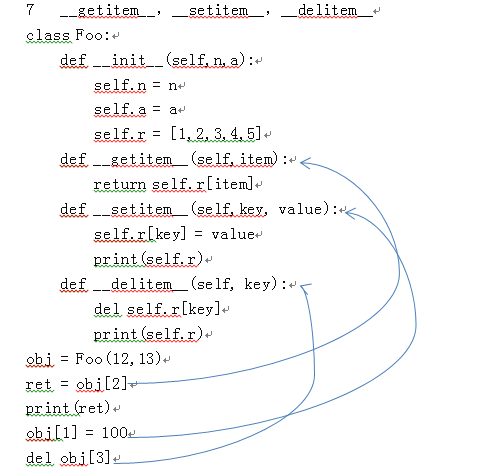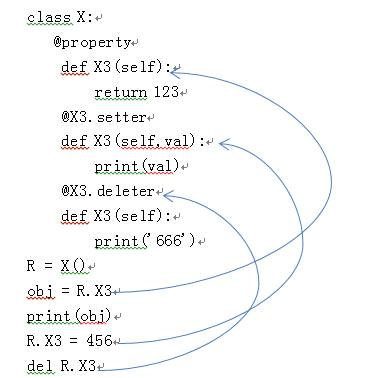1.1. 方法分类
1)普通方法(实例函数) 保存在类中,由对象来调用,类不能直接调用,self=》对象
2)静态方法(类函数) 保存在类中,由类直接调用,不需要传递参数 @staticmethod
3)类方法(类函数),保存在类中,由类直接调用,默认参数 cls=》当前类 @classmethod
4)特殊方法
区别
1、静态方法和类方法都不可以访问实例变量
2、类方法可以访问类变量,静态方面不能访问类变量
3、类函数(静态方法、类方法)并不一定需要实例化对象,类可以直接调用
3、静态方法中实例对象共享一块内存地址
示例
1.1.1. 构造方法(待深入)
__new__() 方法是在类准备将自身实例化时调用
__new__() 方法始终都是类的静态方法,即使没有被加上静态方法装饰器
Python 首先调用 __new__() 方法,在 __init__() 启动之前
class Foo():
def __init__(self, name,age):
self.n = name
self.a = age
print('%s-%s'%(self.n,self.a))
def __new__(cls, name,age):
print('this is new')
return object.__new__(cls)
Foo('zk','18')
1.1.2. 初始化
def __init__(self,arg)
obj = 类('a1')
1 普通方法
def show(self):
print(self.name)
1.1.3. 静态方法
class X:
@ staticmethod
def X1(n):
name1 = n
print(name1)
X.X1('zk') #自动执行类中的X1方法
1.1.4. 类方法(类函数)
class X:
@classmethod
def X1(cls,n):
name1 = n
print(name1)
X.X1('zk') #自动执行类中的X1方法,不需要创建对象
1.1.5. 特殊方法
1、__init__ 初始化,类()自动执行
2、__call__ #对象() 类()() 自动执行
class Foo:
def __call__(self, *args, **kwargs):
print("call")
Foo()() #自动执行call里面的方法
3、__int__ int(对象)
class Foo:
def __init__(self,n,a):
self.n = n
self.a = a
def __int__(self):
return self.n+self.a
obj = Foo(12,13)
print(obj, type(obj))
ret = int(obj)
print(type(ret))
print(ret)
4、 __str__ str()
class Foo:
def __init__(self,n,a):
self.n = n
self.a = a
def __str__(self):
return '%s-%s' %(self.n,self.a,)
obj = Foo(12,13)
print(obj) #print(str(obj)) str(obj) obj中__str__,并获取其返回值
5、__add__
class Foo:
def __init__(self,n,a):
self.n = n
self.a = a
def __add__(self,other):
#obj1 = self
#obj2 = other
return (self.n+other.n,self.a+other.a)
obj1 = Foo(12,13)
obj2 = Foo(1,2)
r = obj1+obj2
print(r)
6、 __dict__ 将对象中封装的所有内容通过字典的形式返回
class Foo:
v = 'zg'
def __init__(self,n,a):
self.n = n
self.a = a
def __add__(self,other):
obj1 = self
obj2 = other
return (self.n+other.n,self.a+other.a)
print(Foo.__dict__)
7、__getitem__,__setitem__,__delitem__ 切片(slice类型)或者索引

8、__iter__
# 如果类中有 __iter__ 方法,对象=》可迭代对象
# 对象.__iter__() 的返回值: 迭代器
# for 循环,迭代器,next
# for 循环,可迭代对象,对象.__iter__(),迭代器,next
# 1、执行li对象的类F类中的 __iter__方法,并获取其返回值
# 2、循环上一步中返回的对象
class Foo:
def __init__(self):
self.r = [1,2,3,4]
def __iter__(self):
return iter(self.r)
obj = Foo()
for i in obj:
print(i)
# print(BaseReuqest.__dict__) #包含该类的命名空间的字典
# print(BaseReuqest.__doc__) #类文档字符串或无,如果未定义
# print(RequestHandler.serve_forever.__name__) #类名或函数名
# print(RequestHandler.__module__) #定义类的模块名称。此属性在交互模式下的值为“main”
# print(Son.__bases__) #一个包含基类的空元组,按照它们在基类列表中出现的顺序
# print(RequestHandler.__mro__)
1.1.6. Metaclass 元类
class myType(type):
def __init__(self,*args,**kwargs):
print('myType')
def __call__(self, *args, **kwargs):
obj1 = self.__new__(self,*args,**kwargs)
self.__init__(obj1)
class Foo(object,metaclass = myType):
def __init__(self):
self.r = [1,2,3,4]
print(self.r)
def __new__(cls,*args, **kwargs):
return cls
def func(self):
print("func")
obj = Foo()
1.2. 属性
class X:
@property
def X3(self):
return 123
R = X()
obj = R.X3 #对象调用类方法的时候不需要加()
print(obj)
1.2.1. 属性应用

1.3. 字段(变量)
普通字段(实例变量),保存在对象中,执行只能通过对象访问
静态字段(类变量),保存在类中, 执行可以通过对象访问也可以通过类访问
class Province:
country = '中国' # 静态字段,属于类
def __init__(self, name):
self.name = name # 普通字段,属于对象
1.4. 成员修饰符
共有成员
私有成员, __字段名
- 无法直接访问,只能间接访问
1.4.1. 私有普通字段
class Foo:
def __init__(self, name, age):
self.name = name
# self.age = age
self.__age = age # 私有,外部无法直接访问
def show(self):
return self.__age
obj = Foo('alex', 19)
# print(obj.__age) #报错
print(obj.show())
1.4.2. 私有静态字段
class Foo:
__v = 'zg'
@staticmethod
def show():
print(Foo.__v)
# print(Foo.__v) #报错
Foo.show()
1.4.3. 私有方法
class Foo:
def __show(self):
return 123
def showall(self):
r = self.__show()
return r
obj = Foo()
# print(obj.__show)
print(obj.showall())
1.5. 多态
class A:
def func1(self):
print('thin is func1')
def func2(var):
pass
a = A()
func2(a.func1())
https://www.cnblogs.com/wupeiqi/p/4493506.html